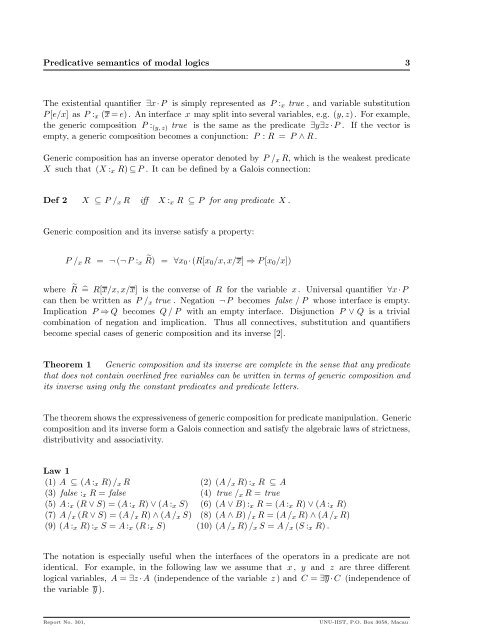IIST and UNU - UNU-IIST - United Nations University
IIST and UNU - UNU-IIST - United Nations University
IIST and UNU - UNU-IIST - United Nations University
You also want an ePaper? Increase the reach of your titles
YUMPU automatically turns print PDFs into web optimized ePapers that Google loves.
Predicative semantics of modal logics 3<br />
The existential quantifier ∃x· P is simply represented as P : x true , <strong>and</strong> variable substitution<br />
P [e/x] as P : x (x = e) . An interface x may split into several variables, e.g. (y, z) . For example,<br />
the generic composition P : (y, z) true is the same as the predicate ∃y∃z · P . If the vector is<br />
empty, a generic composition becomes a conjunction: P : R = P ∧ R .<br />
Generic composition has an inverse operator denoted by P / x R, which is the weakest predicate<br />
X such that (X : x R) ⊆ P . It can be defined by a Galois connection:<br />
Def 2 X ⊆ P / x R iff X : x R ⊆ P for any predicate X .<br />
Generic composition <strong>and</strong> its inverse satisfy a property:<br />
P / x R = ¬ (¬ P : x ˜R) = ∀x0 · (R[x 0 /x, x/x] ⇒ P [x 0 /x])<br />
where ˜R ̂= R[x/x, x/x] is the converse of R for the variable x . Universal quantifier ∀x· P<br />
can then be written as P / x true . Negation ¬ P becomes false / P whose interface is empty.<br />
Implication P ⇒ Q becomes Q / P with an empty interface. Disjunction P ∨ Q is a trivial<br />
combination of negation <strong>and</strong> implication. Thus all connectives, substitution <strong>and</strong> quantifiers<br />
become special cases of generic composition <strong>and</strong> its inverse [2].<br />
Theorem 1 Generic composition <strong>and</strong> its inverse are complete in the sense that any predicate<br />
that does not contain overlined free variables can be written in terms of generic composition <strong>and</strong><br />
its inverse using only the constant predicates <strong>and</strong> predicate letters.<br />
The theorem shows the expressiveness of generic composition for predicate manipulation. Generic<br />
composition <strong>and</strong> its inverse form a Galois connection <strong>and</strong> satisfy the algebraic laws of strictness,<br />
distributivity <strong>and</strong> associativity.<br />
Law 1<br />
(1) A ⊆ (A : x R) / x R<br />
(3) false : x R = false<br />
(5) A : x (R ∨ S) = (A : x R) ∨ (A : x S)<br />
(7) A / x (R ∨ S) = (A / x R) ∧ (A / x S)<br />
(9) (A : x R) : x S = A : x (R : x S)<br />
(2) (A / x R) : x R ⊆ A<br />
(4) true / x R = true<br />
(6) (A ∨ B) : x R = (A : x R) ∨ (A : x R)<br />
(8) (A ∧ B) / x R = (A / x R) ∧ (A / x R)<br />
(10) (A / x R) / x S = A / x (S : x R) .<br />
The notation is especially useful when the interfaces of the operators in a predicate are not<br />
identical. For example, in the following law we assume that x , y <strong>and</strong> z are three different<br />
logical variables, A = ∃z · A (independence of the variable z ) <strong>and</strong> C = ∃y · C (independence of<br />
the variable y ).<br />
Report No. 301,<br />
<strong>UNU</strong>-<strong>IIST</strong>, P.O. Box 3058, Macau
















